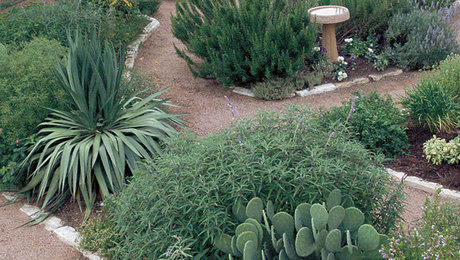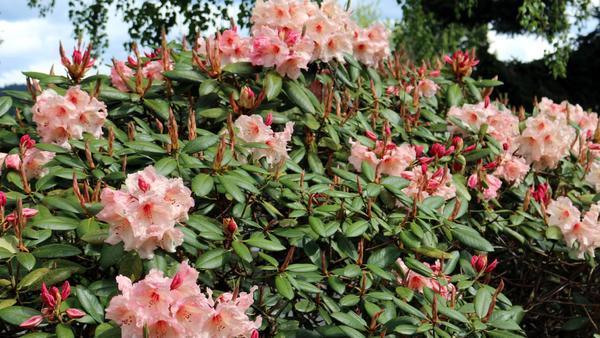
I consider myself extremely lucky. Not only do I love what I do for a living, but I also get to work at home. As an entrepreneur and a woman, my focus was to be at home to raise my daughter and to present her with a positive female role model. So when I started dreaming of my own herb business 14 years ago, I realized I could combine all my joys and my needs into one very personalized enterprise.
My business, Martha’s Herbary, has many sides—cooking and herb classes, a retail store, and demonstration gardens. I knew the demonstration gardens would need thoughtful, creative planning because they would play many roles in the business. I needed a series of gardens that could be used for demonstration, for hands-on cooking classes, for my popular herb garden apprenticeship program, and for my customers. Seeing just how plants grow helps people to decide what their needs are for their own gardens.
As with most projects, what I set out to create is not exactly what manifested itself. Gardens have energy of their own, and once I started designing mine, they developed in different ways than originally planned.
Location, location, location


Our four-acre corner lot is located at a busy intersection in rural northeastern Connecticut. The house and shop are perched in the corner closest to the road. The gardens sprawl out from the back and side of the building, making it ideal when people approach the shop. Most people explore the gardens first because they are what you notice when you arrive, and they are so enticing.
The two acres surrounding the house and shop are fairly flat, bordered by old stone walls, established privet hedges, mature Japanese tree lilacs, and ancient beds of pachysandra. These remnants from the past, although overgrown and neglected when we bought the property, served as natural dividers, partitioning the property into several interesting areas.
Every area we excavated, cleaned up, and cleared out brought the property more and more to life. Townspeople stopped by to say they never realized there was such a great garden space or so many old stone walls here, or that they didn’t know the house had a third story to it. After the neglect the garden had suffered for two decades, I was thrilled that people took notice. And my business developed.
Three-part harmony in the garden
We ended up with three distinct herb gardens, all quite different from each other. They work well together, visually and also in terms of use. Here’s how they came about.

Sunken Medicinal Garden

A sunken garden of medicinal herbs occupies an old house foundation.

One of the most exciting areas for development was a sunken area, surrounded by an old stone house foundation and completely overgrown with poison ivy and an invasive form of euonymus. The ancient stone walls were tumbling down. My husband and I realized this area needed immediate attention to prevent further damage. Richard spent the first summer in our new digs rebuilding the walls, getting rid of the invasive plants, and scratching from a lot of poison ivy.
It was worth it. Not only is this an unusual garden area, but the hidden treasures we uncovered were incredible. To our delight, we discovered huge 5-foot by 10-foot slabs of granite surrounding the gardens, which turned out to be perfect places for lawn chairs. We found hidden stone pathways, overgrown with pachysandra and undergrowth, leading to and encircling this sunken garden area. On either side of the foundation were two stone koi ponds, complete with plumbing that led to the house and a well-thought-out, copper-lined runoff basin, all hidden under years of weeds and leaves.
We decided to devote this garden to medicinal herbs. The area is divided into several beds relating to different aspects of health—such as relaxation, sleep, and well-being. We use the herbs, both fresh and dried, primarily for teas.
Raised-Bed Culinary Garden


The largest portion of the flat area was lawn, with a pet cemetery dating back to 1889, complete with marble headstones. I wanted to keep the burial ground as a focal point because it is so unusual. A privet hedge borders this area, which was the perfect spot for raised beds.
Our raised beds are made from white cedar, handcrafted by an 80-year-old friend. Each bed is of easy interlocking mortise-and-tenon construction (photos at right). No nails are needed, just a mallet to bang in the wooden pins that lock the corners together. The beds provide terrific drainage, are very attractive, and are extremely easy to maintain. The cedar grays nicely, giving the appearance of having been there for a long time.

Flowering Herb Garden

Our next area of exploration was what I now refer to as our formal flowering herb garden. Located in the middle of the largest expanse of lawn, this area is square, measuring approximately 30 feet by 30 feet, with inner rectangular beds. Again, we left the existing lawn for paths, but this time we gave it a very formal look by making all the beds sharply defined with right angles. Entrance to the interior of the garden is from two opposite sides, through tall rusted iron trellises. In keeping with the design of right angles, we chose square trellises instead of rounded ones. When you’re inside this garden, it’s easy to feel as if you’ve entered a garden maze. The trellises and the tall-growing plants enhance the sense of being in a garden room.
It was in these beds that I planted loads of magnificent, tall, flowering herbs such as monarda, anise hyssop, echinacea, and mountain mint, among others. Hops and pink-flowered honeysuckle grow on the trellises. Many of my classes concentrate on making herbal products from fresh flowering herbs. Wreaths and herbal teas are especially successful when fresh herbs are added. My students love making herbal wreaths right out of the garden. Woven tightly together, bursting with color and scent, these wreaths dry on their own in just a week’s time. I allow lots of self-seeding in this garden. Calendula, baby sunflowers, dill, and anise hyssop all drop their seeds for the following year, making this garden an herbal extravaganza.
It is also to this garden that I go for my final “winter” tea. Toting a large open basket and a good sharp pair of shears, I collect all my favorite herbs. For the base, I always include anise hyssop, lemon verbena, lemon thyme, and various mints. These are coarsely chopped into my basket, stems and all. Next I look for a little of all the rest of the fragrant herbs, including some you might not expect to be in tea. Parsley, sage, rosemary, thyme, echinacea, catnip, chamomile, lovage, lemongrass, lavender flowers, and calendula are just a few I include. The resulting combination makes a delicious winter brew, with no caffeine or sweetener.
A simple salve for gardening hands

Rub this fragrant ointment into your hands before and after working in the garden, and before going to bed.
• 1/2 cup olive oil
• 1/4 cup dried lavender flowers
• 5 drops lavender essential oil (optional)
• 2 to 3 Tbs. grated beeswax
Put the olive oil and the flowers in the top of a double boiler and heat ever so gently over simmering water for about 15 minutes. Remove from the heat and strain into a small bowl. Return the oil to the saucepan, and add the lavender essential oil, if using. Add the grated beeswax and heat until melted. To test the consistency, put some of the mixture on a spoon and set it in the fridge for several minutes. If it is too soft, add more beeswax; if too hard, a little more oil. Pour the warm salve into a clean container and let it harden.
Maintaining the Garden

With all the garden space I have, you’d think it would be a huge amount of work. But, in fact, once established, my gardens are easily maintained. Here’s how I keep them manageable.
I took the important first step during construction of the gardens, amending the soil for every bed I created. I am a firm believer in doing the job right the first time. Herbs don’t need a particularly rich soil and lots of fertilizing, but a well-prepared bed will reward you for many years to come. Our soil tends to be claylike, so it holds water well. In general, herbs do not like wet roots. We tilled the area and removed clumps of grass, rocks, and debris. Then we added equal amounts of builder’s sand, compost, and aged manure to beef up the soil. All the beds, whether in-ground or raised, got this treatment.
Planting is the easiest part of this whole operation, but I don’t do it until the soil is soft and fluffy. Nor do I fertilize my beds after the initial soil amendment. Too many nutrients will ensure that the herbs are green and leafy, but they won’t have good oil content and flavor. I am not a believer in watering once the gardens are established, either. Herbs do quite well with very little water. Remember, most are indigenous to the Mediterranean coastal area, where the climate is characterized by intense sun, wind, and not a lot of rain. Withholding water encourages the roots to travel deep in search of water, creating a strong root system that will anchor the plant during storms. Shallow watering, on the other hand, promotes surface roots that are not strong, so the plants don’t fare well without being watered every day.
I mulch to conserve water in the soil and to cut down on weeding. My favorite mulch to use with herbs growing in sun is cocoa bean hulls. The few herbs I grow in shade I don’t bother to mulch, since weeds aren’t a problem with them. I apply the mulch thickly, 2 to 3 inches deep, around the beginning of June, after I’ve done the majority of my spring planting. This mulch cover really helps to cut down on the weeding. Also, as the garden matures, the plants get bigger and the weeds are crowded out. The raised beds are so easy to maintain that pulling a few weeds daily takes care of it. I do a general big cleanup in the spring and again in the fall. In between, a couple of hours every two weeks during the growing season is what’s needed to keep the rest of my gardens looking good.
In general, the best time to cut back and reshape herbs is right after they bloom. After the first frost, when the perennial herbs have naturally sent their energy back to the roots and the annuals like basil and dill have reached the end of their life cycle, I cut them back even more. A tidy garden looks better in winter and shows off the structure or the “bones” of the garden better. Cleanup is critical for a disease-free garden, too.
I’m lucky to have a big lot with different areas for planting, but the size of an herb garden is not important. You can get as much pleasure from a 4-foot by 8-foot raised bed as from an acre of herbs. For me, the joy comes from the feeling I get when I roam the garden, picking and sniffing the various herbs, plotting what I’m going to make from them. Will they enhance my dinner menu, or will they float in a bowl of steaming water for a facial? Herbs bring me closer to the earth, closer in touch with myself. My gardens have the most wonderful ability to soothe and calm me. Letting yourself go in a garden of herbal delights is a pleasure you should not miss.
So, you want to launch your own herb business?

Any new business has several strikes against it before the doors even open. There is a lot of competition these days, and plenty of discount stores that offer lots for less, so first off, be committed to your venture. Be prepared to work non-stop everyday for several years establishing yourself. You will live, breathe, and eat your business idea. Do you have a partner in life? He or she had better be ready for your obsession, because that’s what it takes.
Location is extremely important. It will have a big effect on the overall outcome of your business. Most successful herb businesses are located in rural, somewhat out of the way, places.
How will you build your clientele? Conventional advertising is expensive. Word of mouth is a sure bet and a wonderful form of advertisement, but it takes a long time. It was eight years before my business really got off the ground. Creating gardens helped, because it brought me immediate attention. People love to see what others are doing in their gardens.
How will you make money? Retail? Classes? Lectures? Make sure you have a clear idea of this. Also, remember that gardening is a seasonal activity. My business has many facets to it, all bringing in income at various times of year. The whole idea is to even out the income so there aren’t very lean times.
Create a special niche for your business. To do that, first picture who you want for customers. What image do you want the public to see? Remember to create an atmosphere that people thrive in, one that they will want to return to week after week. It is the steady, consistent customers that make a business. What will make people want to come back time and time again? I always try to think of ways to educate my students about something new and different.
I read somewhere that not having a lot of capital when starting a business is a good thing. I have to agree. You avoid many pitfalls that you just can’t afford. It also makes you very creative and resourceful.
Last of all, be prepared to take some risks. You’ll never find out what could have been if you don’t try. —M.P.
Fine Gardening Recommended Products

Gardena 3103 Combisystem 12-Inch To 20-Inch Adjustable Metal Fan Rake Head
Fine Gardening receives a commission for items purchased through links on this site, including Amazon Associates and other affiliate advertising programs.

Planting in a Post-Wild World: Designing Plant Communities for Resilient Landscapes
Fine Gardening receives a commission for items purchased through links on this site, including Amazon Associates and other affiliate advertising programs.

Alpine Corporation 28" Tall Outdoor Birdbath with Scrollwork Decoration Yard Statue
Fine Gardening receives a commission for items purchased through links on this site, including Amazon Associates and other affiliate advertising programs.


















Comments
Log in or create an account to post a comment.
Sign up Log in